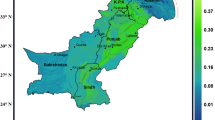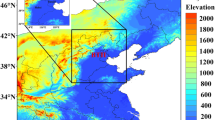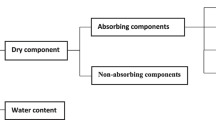Abstract
In order to assess the status of aerosol pollution in three selected Northeast Provinces of China, Ozone Monitoring Instrument/Aura Near UV Aerosol Optical Depth and Single Scattering Albedo 1-orbit L2 Swath 13 × 24km V003 (OMAERUV) daily product data was used to evaluate (1) the ultraviolet aerosol index (UVAI) temporal and spatial distribution of the three Northeast Provinces from 2009 to 2018; (2) the potential pollution source areas of provincial capital cities; and (3) future trend changes. Furthermore, the influencing factors were also analyzed and are discussed herein. The results show that the UVAI in the Northeast Provinces exhibit an overall increasing trend, with an average annual increase rate of 2.99%. Seasonally, the UVAI increasing trend in winter is higher than in spring which in turn is higher than autumn. And summer has the least increasing trend. In addition, the external source of absorbent aerosol transmission is mainly in the southwest. Moreover, the overall UVAI remains relatively constant in the central part of the region, and increases slightly and significantly in the south and north directions. In general, spring, autumn, and winter all exhibit increasing trends in varying degrees. The difference between the forecasted and actual UVAI values in the Northeast Provinces does not exceed 10%; thus, the forecasting reliability is good. Also, UVAI has different degrees of correlation with natural factors, such as precipitation and temperature. With respect to social factors, UVAI and population density (a social factor) are positively correlated in 98.2% of the study area, demonstrating that there is a strong positive correlation between UVAI and smoke and dust emissions.










Similar content being viewed by others
Data availability
Example 1: The data for UVAI analysis in this study originated from the NASA website. The original dataset data can be accessed from: https://disc.gsfc.nasa.gov/miradorguide?tree=project&project=OMI&dataGroup=L2_V003&dataset=OMNO2.003&version=003&year=2018&longname=OMI%2FAura&tdsourcetag=s_pcqq_aiomsg
Example 2: The DEM, precipitation, wind direction, wind speed, and temperature data used herein are from the Resource Science Data Center of the Chinese Academy of Sciences (http://www.resdc.cn), and the population density data is from the LandScan data website (https://landscan.ornl.gov). Many socio-economic and human activity data such as GDP, secondary industry GDP, building construction area, total energy consumption, and smoke and dust emissions are from the National Bureau of Statistics of the People’s Republic of China.stats.gov.cn) and Guangdong Provincial Bureau of Statistics (http://stats.gd.gov.cn/tjsj186/index.html).
References
Adesina, A. J., Piketh, S., Kanike, R. M., Venkataraman, S. (2017). Characteristics of columnar aerosol optical and microphysical properties retrieved from the sun photometer and its impact on radiative forcing over Skukuza (South Africa) during 1999–2010. Environmental Science and Pollution Research, 24, 16160–16171. https://doi.org/10.1007/s11356-017-9211-2.
Alam, K., Trautmann, T., Blaschke, T., & Majid, H. (2012). Aerosol optical and radiative properties during summer and winter seasons over Lahore and Karachi. Atmospheric Environment, 50, 234–245. https://doi.org/10.1016/j.atmosenv.2011.12.027.
Baek, K. H., Kim, J. H., Park, R. J. Chancec, K., Kurosu, T. P. (2014). Validation of OMI HCHO data and its analysis over Asia. Science of the Total Environment, 490, 93–105. https://doi.org/10.1016/j.scitotenv.2014.04.108.
Boeke, N. L., Marshall, J. D., Alvarez, S., Chance, K. V., Fried, A., Kurosu, T. P., Rappenglück, B., Richter, D., Walega, J., Weibring, P., Millet, D. B. (2011). Formaldehyde columns from the Ozone Monitoring Instrument: Urban versus background levels and evaluation using aircraft data and a global model. Journal of Geophysical Research: Atmospheres, 116. https://doi.org/10.1029/2010JD014870.
Che, H., Zhao, H., Wu, Y., Xia, X., Zhu, J., Dubovik, O., et al. (2015). Application of aerosol optical properties to estimate aerosol type from ground-based remote sensing observation at urban area of northeastern China. Journal of Atmospheric and Solar-Terrestrial Physics, 132, 37–47. https://doi.org/10.1016/j.jastp.2015.06.015.
Chen, C., Zhang, H., Li H. (2020). Chemical characteristics and source apportionment of ambient PM1.0 and PM2.5 in a polluted city in North China plain. Atmospheric Environment, 242. https://doi.org/10.1016/j.atmosenv.2020.117867.
Chen, Q., Ding, J., Zhang, Z.,Wang, X., Pu, W., Liu, B., Cao, X. (2019). Black carbon in seasonal snow across northern of Xinjiang. China Environmental Science, 39, 83–91. https://doi.org/10.19674/j.cnki.issn1000-6923.2019.0010.
Chen, X., Ju, T., Zhang, J., Xian, L.,Wang, P., Zhang, S. (2019). Correlation between atmospheric ozone and precursor and meteorological factors in Lanzhou City. Research of Environmental Sciences, 32, 2075–2083. https://doi.org/10.13198/j.issn.1001-6929.2019.06.01.
Chu, D. A., Tsai, T, C., & Chen, J. P. (2013). Interpreting aerosol lidar profiles to better estimate surface PM2.5 for columnar AOD measurements. Atmospheric Environment, 79, 172–187. https://doi.org/10.1016/j.atmosenv.2013.06.031.
de Graaf M., Stamess, P., Torres, O., Koelemeijer, R. (2005) Absorbing Aerosol Index: Sensitivity analysis, application to GOME and comparison with TOMS. Journal of Geophysical Research, 110. https://doi.org/10.1029/2004jd005178.
Eck, T. F., Holben, B. N, Dubovik, O., Smirnov, A., Goloub, P., Chen, H. B., Chatenet, B., Gomes, L., Zhang, X. Y., Tsay, S. C., Ji, Q., Giles, D. Slutsker, I. (2005). Columnar aerosol optical properties at AERONET sites in central eastern Asia and aerosol transport to the tropical mid-Pacific. Journal of Geophysical Research: Atmospheres, 110, n/a-n/a. https://doi.org/10.1029/2004jd005274.
Fan, X., Xia, X., & Chen, H. (2015). Comparison of column-integrated aerosol optical and physical properties in an urban and suburban site on the North China Plain. Advances in Atmospheric Sciences, 32, 477–486. https://doi.org/10.1007/s00376-014-4097-0.
Fang Y, Cao F, Fan M Y. (2020) Chemical characteristics and source apportionment of water-soluble ions in atmosphere aerosols over the east China sea island during winter and summer. Environmental Science, 41,(3):1025–1035. https://doi.org/10.13227/j.hjkx.201909081.
Feng, Y., Chen, D., & Zhang, X. (2018). Atmospheric aerosol pollution across China: A spatiotemporal analysis of satellite-based aerosol optical depth during 2000–2016. International Journal of Digital Earth, 12, 843–857. https://doi.org/10.1080/17538947.2018.1486892.
Fu, T. M., Cao, J. J., Zhang, X. Y., Lee, S. C., Zhang, Q., Han, Y. M., et al. (2012). Carbonaceous aerosols in China: Top-down constraints on primary sources and estimation of secondary contribution. Atmospheric Chemistry and Physics, 12, 2725–2746. https://doi.org/10.5194/acp-12-2725-2012.
Hu, K., Kumar, R. K., Kang, N., Boiyo, R., & Wu, J. (2018). Spatiotemporal characteristics of aerosols and their trends over mainland China with the recent Collection 6 MODIS and OMI satellite datasets. Environmental Science and Pollution Research, 25, 6909–6927. https://doi.org/10.1007/s11356-017-0715-6.
IPCC. (2013). In: Stocker, T.F., Qin, D., Plattner, G.-K.5, Tignor, M., Allen, S.K., Boschung, J., Nauels, A., Xia, Y., Bex, V., Midgley, P.M. (Eds.), Climate change 2013: the physical science basis. Contribution of Working Group-I to the Fifth 4 Assessment Report of the Intergovernmental Panel on Climate Change, vol. 1535. Cambridge University Press, Cambridge, United Kingdom And New York, NY, USA. https://doi.org/10.1017/CBO9781107415324.
Jeong, J. I., & Park R. J. (2017). Winter monsoon variability and its impact on aerosol concentrations in East Asia. Environmental Pollution, 221, 285–292. https://doi.org/10.1016/j.envpol.2016.11.075.
Kaskaoutis, D., Kosmopoulos, G. P., Kambezidis, H. D., & Nastos, P. T. (2007). Aerosol climatology and discrimination of different types over Athens, Greece, based on MODIS data. Atmospheric Environment, 41, 7315–7329. https://doi.org/10.1016/j.atmosenv.2007.05.017.
Khan, R., Kumar, K. R., & Zhao, T. (2019). The climatology of aerosol optical thickness and radiative effects in Southeast Asia from 18-years of ground-based observations. Environmental Pollution, 254, 113025. https://doi.org/10.1016/j.envpol.2019.113025.
Li, F., Ju,T., Jia, W., Chang, F., Cheng, H., Xie, S. (2018). Temporal and spatial distribution of absorbing aerosols index in Lanzhou based on remote sensing data. Acta Scientiae Circumstantiae, 38, 4582–4591. https://doi.org/10.13671/j.hjkxxb.2018.0348.
Li, F., Ju, T., Ma, C., Xian, L. (2019). Absorption aerosol in Gansu Province based on satellite remote sensing. China Environmental Science, 39, 4082–4092. https://doi.org/10.19674/j.cnki.issn1000-6923.2019.0476.
Li, J., Gao, W., & Cao, L. (2020). Significant changes in autumn and winter aerosol composition and sources in Beijing from 2012 to 2018: Effects of clean air actions. Environmental Pollution. https://doi.org/10.1016/j.envpol.2020.115855.
Li, X., Zhang C., Li W., Anyah, R. O., Tian J. (2019). Exploring the trend, prediction and driving forces of aerosols using satellite and ground data, and implications for climate change mitigation. Journal of Cleaner Production, 223, 238–251. https://doi.org/10.1016/j.jclepro.2019.03.121.
Liu, H., Ju, T., Pei, J., Xie, S., Chen, X., Wang, P., Zhang, J., Xian, L. (2018). Spatial-temporal changes of tropospheric HCHO column density and its impact factors over Heilongjiang Province during 2005~2016. China Environmental Science, 38, 2001–2011. https://doi.org/10.19674/j.cnki.issn1000-6923.20180402.003.
Liu, X., Kondo, Y., Ram, K., Matsui, H., Nakagomi, K., Ikeda, T., et al. (2013). Seasonal variations of black carbon observed at the remote mountain site Happo in Japan. Journal of Geophysical Research: Atmospheres, 118, 3709–3722. https://doi.org/10.1002/jgrd.50317.
Ma, C., Ju, T., Wen, F., Wang, Q., Li, F., Zhang, Y., Zhang, G. (2020). Temporal and spatial variation of tropospheric NO2 based on satellite remote sensing in Gansu Province. China Environmental Science, 40, 956–966. https://doi.org/10.19674/j.cnki.issn1000-6923.2020.0054.
Millet D. B., Jacob, D. J., Boersma, K, F., Fu, T. M., Kurosu, T, P., Chance, K., Heald, C. L., Guenther, X. (2008) Spatial distribution of isoprene emissions from North America derived from formaldehyde column measurements by the OMI satellite sensor. Journal of Geophysical Research, 113, https://doi.org/10.1029/2007jd008950.
Pӧschl, U. (2005). Atmospheric aerosols: composition, transformation, climate and health effects. Atmospheric Aerosols, 44, 7520–7540. https://doi.org/10.1002/anie.200501122.
Ren, Y., Mao, J., Zhao, H., Zhou, C., Gong, X., Rao, Z., Wang, Q., Zhang, Y. (2020). Prediction of aerosol particle size distribution based on neural network. Advances in Meteorology, 132, https://doi.org/10.1155/2020/5074192.
Shen, L., Wang, H., Zhao, T., Liu, J., Bai, Y., Kong, S., Shu, Z. (2020) Characterizing regional aerosol pollution in central China based on 19 years of MODIS data: Spatiotemporal variation and aerosol type discrimination. Environmental Pollution, 263, https://doi.org/10.1016/j.envpol.2020.114556.
Shi, K. (2019). Spatial and temporal variation of drought and causes of climate driving in three Northeast Provinces. Dalian University of Technology. https://doi.org/10.26991/d.cnki.gdllu.2019.002544.
Tan, C., Zhao, T., Xu, X., Liu, J., Zhang, L., & Tang, L. (2015). Climatic analysis of satellite aerosol data on variations of submicron aerosols over East China. Atmospheric Environment, 123, 392–398. https://doi.org/10.1016/j.atmosenv.2015.03.054.
Tao, J., Gao, J., Zhang, L., Wang, H., Qiu, X., Zhang, Z., et al. (2016). Chemical and optical characteristics of atmospheric aerosols in Beijing during the Asia-Pacific Economic Cooperation China 2014. Atmospheric Environment, 144, 8–16. https://doi.org/10.1016/j.atmosenv.2016.08.067.
Torres, O., Tanskanen, A., Veihelmann, B., Ahn, C., Braak, R., Bhartia, P. K., Veefkind, P., Levelt, P. (2007) Aerosols and surface UV products from Ozone Monitoring Instrument observations: An overview. Journal of Geophysical Research, 112, https://doi.org/10.1029/2007jd008809.
Vachaspati, C., & V., Begam, G, R., Ahammeda, Y, N., Kumar, K, R., Reddy, R, R. (2018). Characterization of aerosol optical properties and model computed radiative forcing over a semi-arid region Kadapa in India. Atmospheric Research, 209, 36–49. https://doi.org/10.1016/j.atmosres.2018.03.013.
Wang, X., Wang, B. (2019). Research on prediction of environmental aerosol and PM2.5 based on artificial neural network. Neural Computing and Applications, 31, 8217–8227.https://doi.org/10.1007/s00521-018-3861-y.
Xia, D., Tu, J., Li, L., Li, Y., & Luo, X. (2018). Characteristics of the sea breeze from January to March 2014 in Guangzhou area and its effect on aerosol. Guangdong Meteorology, 40, 29–32.
Xian, L., Ge,J., Xu, M., Chen, X., Wang, S., Xie, S., Hu,W. (2018). Remote sensing monitoring of tropospheric HCHO column concentration and influential factors over pearl river delta, China. China Environmental Science, 38, 3221–3231. https://doi.org/10.19674/j.cnki.issn1000-6923.2018.0344.
Xiao, Q., Zhang, H., Choi, M., Li, S., Kondragunta, S., Kim, J., et al. (2016). Evaluation of VIIRS, GOCI, and MODIS Collection 6 AOD retrievals against ground sunphotometer observations over East Asia. Atmospheric Chemistry and Physics, 16, 1255–1269. https://doi.org/10.5194/acp-16-1255-2016.
Xue, S. (2016). Impact of climate change on climate productivity in three provinces of Northeast China. Northwest Normal University.
Yan, U., Liu, Z., Gao, W. (2020). Physiochemistry characteristics and sources of submicron aerosols at the background area of North China Plain: Implication of air pollution control in heating season. Atmospheric Research, 249, https://doi.org/10.1016/j.atmosres.2020.105291.
Yimier, N., Shabiti, M., Maimaiti Y. (2019). Spatiotemporal variation of vegetation NDVI and its relationship with climatic factors on the northern slope of the Tianshan Mountains. Arid Zone Research, 36, 1250–1260. https://doi.org/10.13866/j.azr.2019.05.23.
Yu, X., Lu, R., Liu, C., Yuan, L., Shao, Y., Zhu, B., & Lei, L. (2017). Seasonal variation of columnar aerosol optical properties and radiative forcing over Beijing China. Atmospheric Environment, 166, 340–350. https://doi.org/10.1016/j.atmosenv.2017.07.011.
Zhang, C., Zhao.T., Wang, F., Xu, X., Su, H., Cheng, H., Tan, C. (2017). Variations in aerosol optical depth over three Northeastern Provinces of China, in 2003–2014. Environmental Science. 38, 476–484. https://doi.org/10.13227/j.hjkx.201608043.
Zhang, H., Yu,C., Su, L., Li, L., Fan, M., Wang, Y., Chen, L. (2017). Emission control effects observed from space during the military parade 2015 in Beijing. Journal of Remote Sensing. 21, 622–632. https://doi.org/10.11834/jrs.20175337.
Zhang, Y., Tang, L., & Yu, H. (2015). Chemical composition, sources and evolution processes of aerosol at an urban site in Yangtze River Delta, China during wintertime. Atmospheric Environment, 123, 339–349. https://doi.org/10.1016/j.atmosenv.2015.08.017.
Zhang, Y., Tang, L., Yu, H., Wang, Z., Sun, Y., Qin, W., et al. (2015). Chemical composition, sources and evolution processes of aerosol at an urban site in Yangtze River Delta, China during wintertime. Atmospheric Environment, 123, 339–349. https://doi.org/10.1016/j.atmosenv.2015.08.017.
Zhang, Z., Chen, B., Wang, H., Zhang, G., Zhang, Y. (2017). Spatial and temporal characteristic of absorbing aerosols during APEC based on OMI date. Journal of Lanzhou University (Natural Sciences), 53, 93–100. https://doi.org/10.13885/j.issn.0455-2059.2017.01.014.
Zhao, N., Cao, F., Tian, Q., Chen, Y., Liu, Q., Huang, Y., Wang, Y. (2019). Spatial-temporal distribution of absorptive aerosols in the Yangtze River Delta. Environmental Science, 40, 3898–3907. https://doi.org/10.13227/j.hjkx.201811211.
Zhao, S., Tie, X., Cao, J., Li, N., Li, G., Zhang, Q., et al. (2015). Seasonal variation and four-year trend of black carbon in the Mid-west China: The analysis of the ambient measurement and WRF-Chem modeling. Atmospheric Environment, 123, 430–439. https://doi.org/10.1016/j.atmosenv.2015.05.008.
Acknowledgements
This research satellite data come from NASA Goddard Earth Sciences Data and Information Services Center (GES DISC) in the USA. We appreciate the linguistic assistance provided by TopEdit (www.topeditsci.com) during the preparation of this manuscript.
Author information
Authors and Affiliations
Corresponding author
Additional information
Publisher's Note
Springer Nature remains neutral with regard to jurisdictional claims in published maps and institutional affiliations.
Rights and permissions
About this article
Cite this article
Duan, J., Ju, T., Wang, Q. et al. Absorbable aerosols based on OMI data: a case study in three provinces of Northeast China. Environ Monit Assess 193, 479 (2021). https://doi.org/10.1007/s10661-021-09249-x
Received:
Accepted:
Published:
DOI: https://doi.org/10.1007/s10661-021-09249-x




